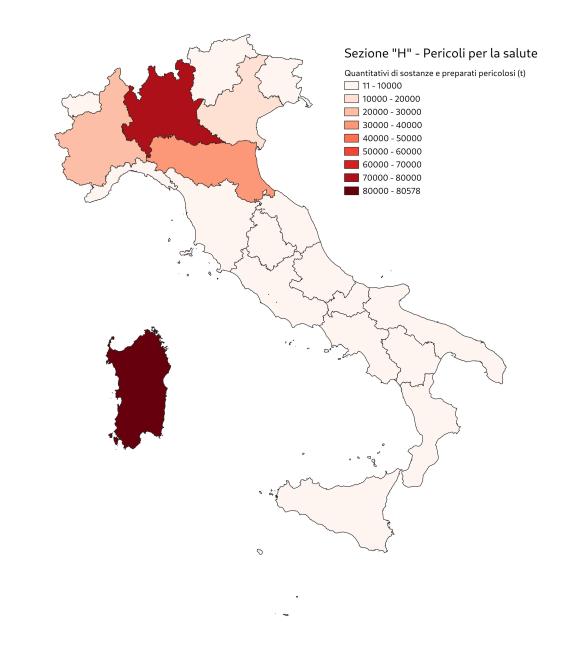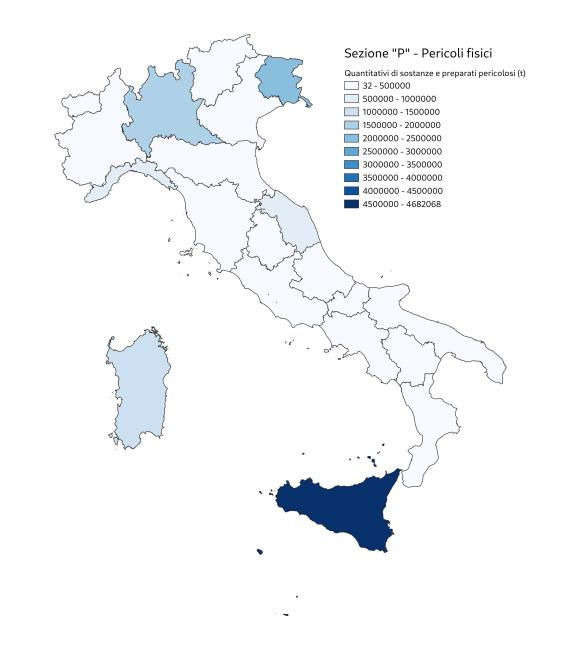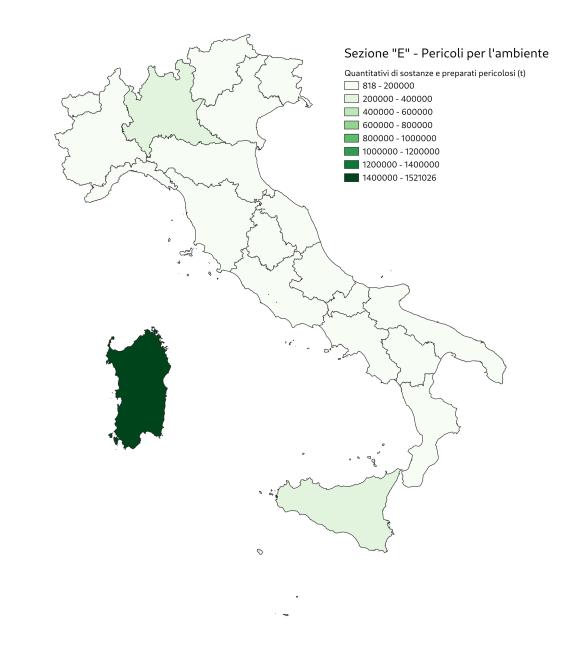Panel 1
Fabrizio Vazzana, Francesca Pepe
The indicator analyzes the type of substances or categories of hazardous substances/mixtures most prevalent in facilities at risk of major accidents, present throughout Italy and declared by the managers of the facilities subject to Legislative Decree 105/2015. Among the categories of hazardous substances (Annex 1 - Part 1 of Legislative Decree 105/2015) most widespread in quantitative terms are those belonging to Section "P" - Physical Hazards, particularly flammable liquids. Environmentally hazardous substances falling into the hazard category "E" - Environmental Hazards are also very widespread. The regions with the highest presence of toxic substances are Sardinia, followed by Lombardy, Emilia-Romagna, and Piedmont. The region with the highest quantities of flammable substances is Sicily, followed by Friuli-Venezia Giulia, Lombardy, and Sardinia. There is a significant presence, distributed throughout Italy, of flammable liquefied gases and natural gases (LPG and methane) and petroleum products.
It is possible to obtain useful information for the hazard map associated with a plant, in addition to the activity carried out, also from the quantities, typology and properties of the hazardous substances and mixtures present in it. This indicator analyses the typology of substances or categories of hazardous substances/mixtures most widespread in plants at risk of major accidents, present on the national territory and declared by the managers of the plants (lower and upper threshold) subject to Legislative Decree 105/2015, as specified respectively in Annex 1 - Part 1 (categories of hazardous substances) and Part 2 (specified hazardous substances) of the same decree.
Estimate the prevalent nature of the risks to which humans, air, soil, subsoil, groundwater and surface water are subject in relation to the presence of certain dangerous substances and mixtures in establishments at risk of major accidents.
D. Lgs. 105/2015
Panel 2
ISPRA-MASE, Inventario Seveso
ISPRA, Annuario dei dati ambientali - Vari anni
It depends on the timeliness and accuracy of the information that reaches ISPRA from the managers, now subjected to a validation process before approval.
None
Data quality assessment
All information comes from the National Inventory of establishments likely to cause major accidents, provided for by Article 5, paragraph 3 of Legislative Decree 105/2015. https://www.rischioindustriale.isprambiente.gov.it/seveso-query-105/Default.php
https://www.rischioindustriale.isprambiente.gov.it/seveso-query-105/Default.php
National, Regional
2019-2025
Indicator assessment
All information is taken from the National Inventory of establishments likely to cause major accidents, provided for by Article 5, paragraph 3 of Legislative Decree 105/2015. The inventory allows the extraction of an Excel file that allows to extrapolate after different steps, the data necessary for updating the indicator.
At present, given that managers have now reached a sufficient level of knowledge in completing the notification form and correctly classifying the substances present, no significant fluctuations are expected in the future.
Compared to the previous survey in December 2025, a significant increase in environmentally hazardous substances has been identified in Sardinia, Lombardy, and Sicily, while the other total quantities remain virtually constant.
Data
Tabella 1-Quantità complessiva sostanze per categorie
Inventario ISPRA
Tabella 2-Quantità complessiva sostanze specificate
Inventario ISPRA
Tabella 4-Dettaglio (maggiore diffusione) sostanze specificate per regione
Inventario ISPRA



Tables 1 and 2 provide, for your convenience, the following information: - the number of occurrences per hazard class. Please note that in this case, substances belonging to multiple hazard classes appear multiple times; - the number of establishments that have notified the substance; - the total amount of the substance present in the country resulting from the sum of the quantities present in the establishments that have notified it; - the hazard statements for each substance or category of substances; Among the categories of hazardous substances in Annex 1 - Part 1 of Legislative Decree 105/2015, the most widespread in quantitative terms, is the category of substances belonging to Section "P" - Physical hazards, in particular flammable liquids. Also very widespread are substances hazardous to the environment that fall into the hazard category "E" - Environmental hazards (Table 1). Among the hazardous substances specified in Annex 1 - Part 2 of Legislative Decree 105/2015, a significant presence, distributed throughout Italy, of flammable liquefied gases and natural gases (LPG and methane) and petroleum products (gasoline, diesel fuel, kerosene, and fuel oil) is evident. A significant presence of methanol and oxygen is also noted; finally, although concentrated in some regions, particularly significant quantities of ammonium nitrates and anhydrous ammonia are noted. For a more detailed analysis, the regional distribution of the notified substances across Italy was also analyzed (Tables 3 and 4). The hazardous substances included in Annex 1, Part 1, are grouped into categories with similar hazardous characteristics, namely: Section "E" - Environmental Hazards and Section "H" - Health Hazards (which includes acutely toxic substances), Section "O" - Other Hazards, and Section "P" - Physical Hazards (which includes explosive, flammable, and oxidizing substances). The regions with the highest concentrations of toxic substances are Sardinia and Lombardy, followed by Emilia-Romagna and Piedmont. It should be noted that the region with the highest concentrations of flammable substances is Sicily, followed by Friuli-Venezia Giulia, Lombardy, and Sardinia. Similarly, Sicily is the region with the highest concentrations of environmentally hazardous substances, followed by Lombardy. The hazardous substances included in Section O - Other Hazards are present in less significant quantities, with the regions with the highest concentrations being Lombardy and Tuscany. Regarding the substances notified in Annex 1 - Part 2 of Legislative Decree 105/2015, some of the most widespread substances in Italy have been reported, such as liquefied gases and methane, petroleum products, methanol, oxygen, chlorine, and toluene diisocyanate. It should be noted that liquefied gases (LPG), natural gas, and petroleum products (gasoline, diesel, kerosene, and fuel oil) are fairly evenly distributed throughout Italy, with peaks for gases (LPG and methane, referring to underground natural gas storage), in Lombardy, Emilia-Romagna, and Abruzzo, while for petroleum products, Sicily is the location of petroleum refining plants. For the other substances examined, specific concentrations are recorded in some regions: Emilia-Romagna for methanol, Tuscany for chlorine, and Lombardy for oxygen and toluene diisocyanate (Table 4). It should be noted that since the data in the tables are a function of various factors, in some cases an attempt has been made to provide additional brief information, which however is insufficient for a complete and detailed analysis of the data, an objective that is deferred to more specialized publications from the Institute.